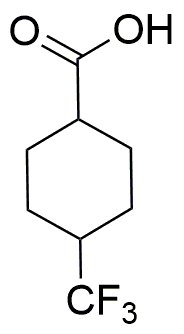4-(Trifluoromethyl)cyclohexanecarboxylic acid is widely utilized in research focused on:
- Pharmaceutical Development: This compound serves as a key intermediate in the synthesis of various pharmaceuticals, particularly those targeting metabolic and cardiovascular diseases, due to its unique trifluoromethyl group that enhances bioactivity.
- Agricultural Chemicals: It is used in the formulation of agrochemicals, including herbicides and fungicides, where its properties help improve efficacy and selectivity, making it valuable for crop protection.
- Material Science: The compound is explored in the development of advanced materials, such as polymers and coatings, where its fluorinated structure contributes to enhanced chemical resistance and durability.
- Fluorinated Solvents: It is utilized in the production of specialty solvents that are effective in various chemical reactions, offering advantages like lower toxicity and improved environmental profiles compared to traditional solvents.
- Research Reagents: In laboratory settings, it acts as a reagent for synthesizing other complex molecules, facilitating research in organic chemistry and enabling the development of new compounds with desirable properties.
General Information
Properties
Safety and Regulations
Applications
4-(Trifluoromethyl)cyclohexanecarboxylic acid is widely utilized in research focused on:
- Pharmaceutical Development: This compound serves as a key intermediate in the synthesis of various pharmaceuticals, particularly those targeting metabolic and cardiovascular diseases, due to its unique trifluoromethyl group that enhances bioactivity.
- Agricultural Chemicals: It is used in the formulation of agrochemicals, including herbicides and fungicides, where its properties help improve efficacy and selectivity, making it valuable for crop protection.
- Material Science: The compound is explored in the development of advanced materials, such as polymers and coatings, where its fluorinated structure contributes to enhanced chemical resistance and durability.
- Fluorinated Solvents: It is utilized in the production of specialty solvents that are effective in various chemical reactions, offering advantages like lower toxicity and improved environmental profiles compared to traditional solvents.
- Research Reagents: In laboratory settings, it acts as a reagent for synthesizing other complex molecules, facilitating research in organic chemistry and enabling the development of new compounds with desirable properties.
Documents
Safety Data Sheets (SDS)
The SDS provides comprehensive safety information on handling, storage, and disposal of the product.
Product Specification (PS)
The PS provides a comprehensive breakdown of the product’s properties, including chemical composition, physical state, purity, and storage requirements. It also details acceptable quality ranges and the product's intended applications.
Certificates of Analysis (COA)
Search for Certificates of Analysis (COA) by entering the products Lot Number. Lot and Batch Numbers can be found on a product’s label following the words ‘Lot’ or ‘Batch’.
Numéro de catalogue
Numéro de lot/série
Certificates Of Origin (COO)
This COO confirms the country where the product was manufactured, and also details the materials and components used in it and whether it is derived from natural, synthetic, or other specific sources. This certificate may be required for customs, trade, and regulatory compliance.
Numéro de catalogue
Numéro de lot/série
Safety Data Sheets (SDS)
The SDS provides comprehensive safety information on handling, storage, and disposal of the product.
DownloadProduct Specification (PS)
The PS provides a comprehensive breakdown of the product’s properties, including chemical composition, physical state, purity, and storage requirements. It also details acceptable quality ranges and the product's intended applications.
DownloadCertificates of Analysis (COA)
Search for Certificates of Analysis (COA) by entering the products Lot Number. Lot and Batch Numbers can be found on a product’s label following the words ‘Lot’ or ‘Batch’.
Numéro de catalogue
Numéro de lot/série
Certificates Of Origin (COO)
This COO confirms the country where the product was manufactured, and also details the materials and components used in it and whether it is derived from natural, synthetic, or other specific sources. This certificate may be required for customs, trade, and regulatory compliance.


